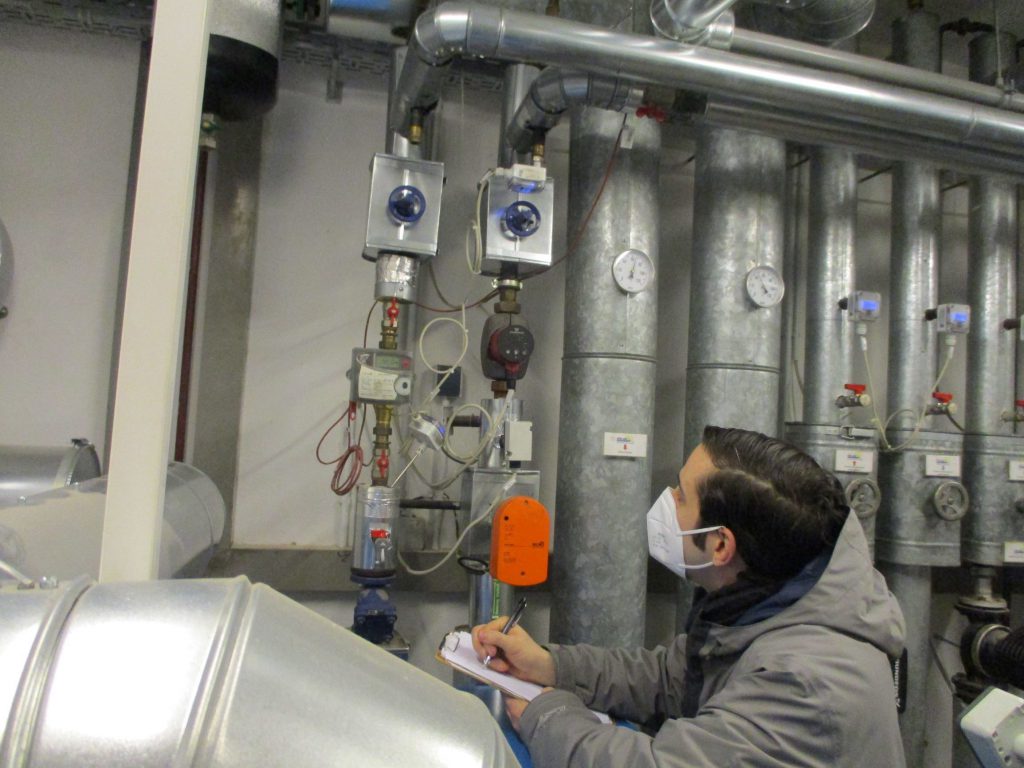By Brian Stern, Colby Hoefar, CFM, LEED AP, Jennifer Brainerd, and Jim Perkins, CEM, CBCP, LEED AP
In December 2021, President Biden signed Executive Order 14057, Catalyzing Clean Energy Industries and Jobs Through Federal Sustainability. This directed the federal government to move toward carbon-free electricity by 2035 and establish ways to reach net zero emissions from buildings by 2050.
While the Department of Defense faces several challenges in achieving this target, there are a number of strategies that can be borrowed from the commercial sector to make the transition easier. An ongoing project conducted with San Diego State University aims to provide the school with a comprehensive action plan to achieve carbon neutral operations by 2030. Adopting a similar approach, with considerations for the unique mission, needs, and geographies of defense facilities, can be applied for military installations seeking transformation to meet carbon neutrality goals.

improvement. PHOTO BY WILLIAM FARROW, USACE HUNTSVILLE CENTER
DELIVERING A PLAN
When considering the transition of a military installation or any other campus to carbon neutrality, the keys are to understand the existing facilities, their goals or mission, what the needs of the users are, and the overall function of the buildings.
For military installations, the first step is to look at the existing inventory of building data, or, if this is not available, to conduct a facility condition assessment using BUILDER. The sustainment management system slices the building into different systems—such as HVAC, electrical, and plumbing—and captures information at the individual asset level, which is then folded into the building condition index. This data can be utilized in combination with energy assessments to develop work plans that consider all energy and water conservation opportunities, prioritize them, and help the client reduce energy consumption.
An example of this approach came from a project carried out with the Mississippi National Guard, which needed to meet the requirements of the Energy Independence and Security Act of 2007. Energy and water audits were conducted of its overall facility network, which included 44 sites comprising 160 buildings and over 1.5-million-ft². Integrated teams accomplished site visits for both the energy audits and the facility inventory and condition assessments needed to support implementation of BUILDER. The energy auditors established a baseline and built a picture of potential opportunities.
The team was able to leverage BUILDER data effectively to identify energy and carbon measures, then provide the Mississippi National Guard with a list of energy saving recommendations on a variety of projects. In this instance, the auditors utilized information they collected to assess component and system upgrade opportunities and lifecycle cost analysis.
Across similar projects throughout the Defense Department, the easiest path often is to reduce the energy need on each campus or find those areas where efficiency can be increased. There are many simple solutions that allow for a reduction in the amount of energy needed to be decarbonized. For the Mississippi National Guard, identified energy conservation measures included retrofitting areas that have high hours of occupancy with LED lighting; adding occupancy sensors to replace manual light switches in corridors and spaces with variable occupancy; adding simple direct digital control enhancements to HVAC systems; retro-commissioning buildings that have direct digital control systems; and replacing existing constant speed natural gas-fired furnaces with variable speed furnaces to conserve fan energy in the cooling dominated climate.
REGIONAL CONSIDERATIONS
Each installation’s geographic environment has a large impact on its energy needs. In a location like South Dakota, the winter cold can be extreme. Continuous heat is necessary to ensure mission success. In humid, coastal climates, corrosion can negatively affect the lifecycle of building assets at a rapid pace. By conducting a facility condition assessment and analyzing energy requirements, installations can accurately plan for upgrades to reach efficiency goals while maintaining continuous power for the mission.
Energy conservation opportunities and asset distresses can be wildly different. Both assessment and energy teams saw this during projects for the South Dakota Army National Guard and California Army National Guard. By having a broader perspective and experience base spanning the United States, project teams can recognize viable solutions—incorporating the best fit for the local climate and specific mission requirements.
EMBEDDING EXPERTISE
Embedding resource efficiency managers (REMs) can help public works staff meet energy and water agency goals such as energy and water reduction; improve resilience to the loss of commercial energy supply; improve decarbonization and greenhouse gas reduction; and increase renewable energy production.
REMs provide technical and programmatic support to military clients facing real challenges to maintain readiness while meeting both administration mandates and agency requirements. Because they are embedded with their clients, REMs get to know the details of the base, its processes, its critical missions, and what supports those critical missions. Additionally, REMs are financially offsetting. These staff usually find enough savings through their energy improvement recommendations to pay for their contract and more. Due to the wealth of opportunities for increasing energy efficiencies, some REMs have been on installations for more than 10 years and continue to find ways to save and add value.
BALANCING OVERALL NEEDS
A main challenge when it comes to decarbonization on military bases is resiliency. Mission commanders are rightfully concerned with how to both meet carbon neutrality and maintain mission readiness.
It is critical that installations remain operational while moving toward decarbonization—and there are design solutions to ensure that they do. Microgrids can be designed to incorporate on-site energy sources and energy storage. This allows bases to maintain resilience for critical operations in case the commercial electrical grid goes down. Given the cost parameters and mission impact concerns of complete electrification, including altering the infrastructure and removing diesel generators used for backup power, transformation cannot take place right away. But, with a combination of technologies, installations can move toward electrification and decarbonization. The key is to work with a consultant to identify a roadmap toward the carbon neutrality goal. Following a phased plan over time will move the installation closer to carbon neutrality until the goal is achieved.
INTELLIGENT PLANNING

At San Diego State University, a carbon neutrality plan is being developed that will provide pathways to achieve carbon neutral operations by 2030 for all scope 1, 2, and 3 greenhouse gas emissions.
The project, contracted with Glumac, a Tetra Tech Company, will provide a comprehensive action plan that identifies the total costs of transitioning the campus to a carbon neutral, clean energy infrastructure system. San Diego State has over 70 buildings on campus and a central utility system, which includes a cogeneration plant to provide electrical power, steam heating, and chilled water cooling. As part of the process being undertaken, the existing facilities and energy systems were evaluated to identify specific energy efficiency and decarbonization strategies to understand the costs required to be carbon neutral. Working closely with school leadership, the project team developed an implementation roadmap to schedule projects, flag critical path items, and identify funding strategies to support the decarbonization transition.
Once finalized, the project team will deliver a live interactive carbon scenario planning and risk mitigation tool that continues tracking and monitoring progress, allowing for incorporating future changes such as utility rates or the cost of projects. With this tool, San Diego State or a similar client (military bases and higher education institutions have sizeable overlap) can receive real project cost data and track projects concurrently to determine their trajectory towards achieving carbon neutrality.
A ROADMAP TO SUCCESS
By considering the location of each installation, utilizing a mix of technologies to maintain resiliency, and employing and training staff to identify and implement energy efficiencies, the targets outlined in Executive Order 14057 can be reached: to achieve a carbon pollution-free electricity sector by 2035 and net-zero emissions economy-wide by no later than 2050.
Crucially, it is important to have a plan and understand where the mission is headed, then best align existing funding when the opportunity arises. By employing intelligent planning tools and combining them with input from personnel familiar with military missions and operations, bases can prepare for the associated costs of transitioning to carbon neutrality. Having a roadmap of where you want to go helps in making better decisions around existing facilities—keeping the base on track to meet decarbonization goals.
Brian Stern is Regional Energy Director, Glumac, a Tetra Tech Company; bstern@glumac.com.
Colby Hoefar, CFM, LEED AP, is Asset Management Program Director, Jennifer Brainerd is Energy Services Program Manager, and Jim Perkins, CEM, CBCP, LEED AP is Senior Energy Project Manager, Tetra Tech. They can be reached at colby.hoefar@tetratech.com; jennifer.brainerd@tetratech.com; and jim.perkins@tetratech.com.
More News from TME
-

Reversing the Shrinking Industrial Base
Incentivizing companies to remain as advanced small businesses, without needing to transition to the large fully open competition market, coupled with difficulties for new small businesses to enter federal acquisition, has resulted in a steady pattern of decline in the nation’s defense industrial base, carrying with it risks to innovation, global standing, and national security. -

Fulfilling the Mission
Rear Adm. Dean VanderLey, CEC, USN, Commander, Naval Facilities Engineering Systems Command, sits down with TME to discuss the Department of the Navy’s Systems Command for shore facilities and expeditionary equipment, Naval Facilities Engineering Systems Command (NAVFAC) and its varied responsibility that directly support warfighter lethality. -

A Roadmap for Clean Energy on Kwajalein Atoll
A recent effort led by U.S. Army Space & Missile Defense Command to meet the Army Climate Strategy for operations on Kwajalein Atoll studied potential courses of action that would help the remote installation reach 100 percent carbon-pollution free electricity by 2030.